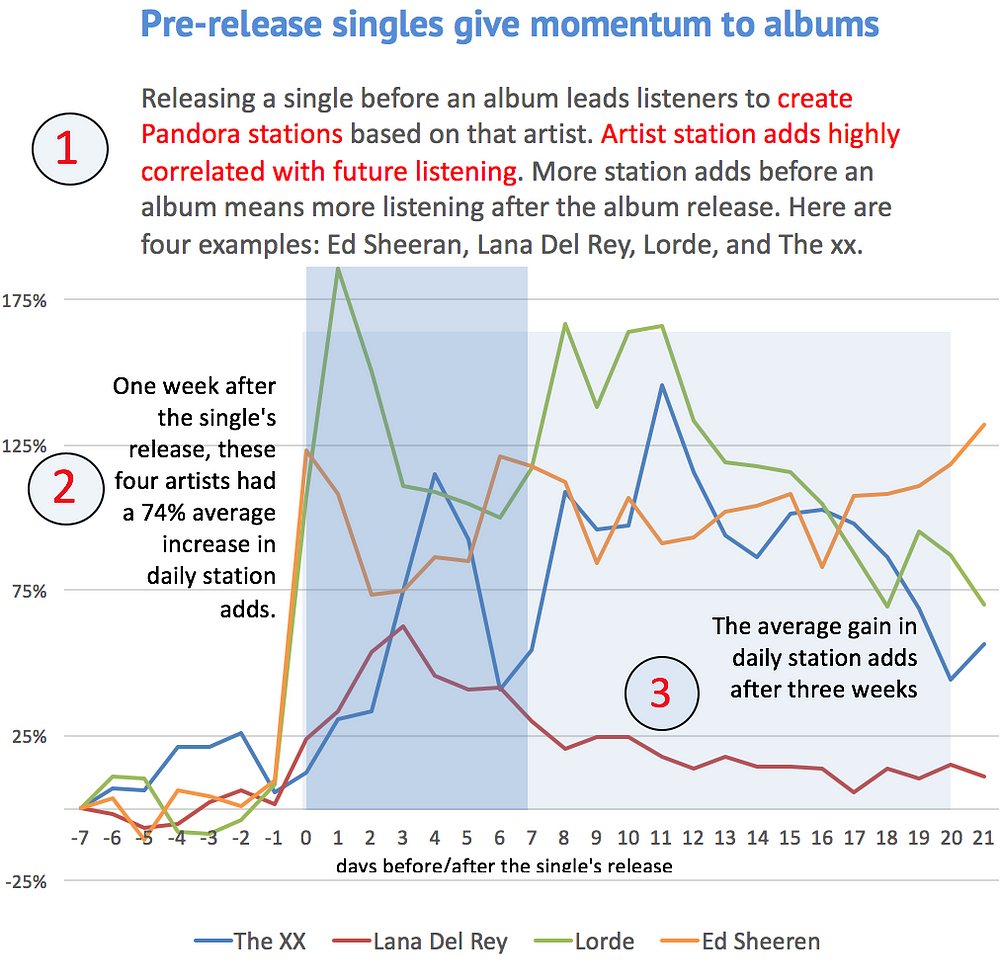When Pandora listeners hear a new single, they create stations based on that artist’s music and hear more of that artist. That’s gold when the single preceded a new album, explains Pandora’s Glenn Peoples.
_______________________________
By Glenn Peoples, Music Insights and Analytics at Pandora

As long as there will be albums, there will be pre-release singles that create buzz, momentum and, if all goes well, greater sales for the album. Not all albums are preceded by a single. But there’s an argument to be made it’s a good practice.
Releasing singles before a new album has been a standard practice for decades. A single would be promoted to radio to build demand for an upcoming album. In the download era, a pre-release single would be (the label hoped) the first step in buying an album. Sometimes, the person who bought the single could buy the album minus the single—sometimes multiple singles—with the price of the singles removed from the purchase.
The pre-release single is different in the streaming era. At Pandora, listeners hear the pre-release single and often create a station based on the performing artist. This is bottom-up demand. If the listener likes the song, they can interact with Pandora by giving it a thumb. If they like a song, it can be a seed—a term that means the basis of something—for a station. A song station add creates a new station that taps into Pandora’s Music Genome Project to play songs with similar characteristics and connections to similar listeners. And if a listener likes an artist, they can also create a station using that artist as a seed. At Pandora, an artist station is a signal a listener wants to hear more of an artist’s music. Adds resulting from a pre-release single help give an album momentum.
For example, the March 2nd release of Lorde’s single “Green Light” more than doubled her artist stations adds: a 121-percent gain in the first week and 119 percent growth rate over three weeks (compared to the week before its released). Her upcoming album, Melodrama,
When The xx released “Say Something Loving,” many listeners added a The xx station to their collection of Pandora stations. This interaction is key. New The xx stations meant more people would hear new songs when the album, I See You, was released a week later. In this case, The xx’s new station adds rose 40 percent the week after “Say Something Loving” was released. Driven by the new album’s release, and no doubt the publicity surrounding it, new station adds were up 61 percent over three weeks after the pre-release single came out.

Ed Sheeran had big gains, too. His artist station adds grew 92 percent in the first week and 97 percent over three weeks. The standard pre-release strategy is to release one single at a time. (It’s not unusual for a label to release multiple singles before an album.) On January 6th, Sheeran and his record label, Elektra Records, took the unusual step of releasing two pre-release singles, “Castle on the Hill” and “Shape of You,” on the same day. If one song can get attention from Sheeran’s media coverage, why not two? The singles’ release started an awareness campaign that lasted through the album release in early March (see this chart at Google Trends of the ascent of search traffic for Ed Sheeran).
Grabbing more spins can such tangible benefits as chart positioning. Both of Sheeran’s pre-release singles debuted in the top ten of Billboard’s January 28 edition of the Hot 100 singles chart, making him the first artist with two songs concurrently in the Hot 100’s top ten. Streaming played a strong role in the historic, first-week feat. Although the main driver that week was download purchases, “Shape of You” had enough streams to debut at #4 on the Streaming Songs chart—without Pandora, whose weekly spin data wouldn’t be added to the Hot 100 until two weeks later. At broadcast radio, where songs often lag behind what’s being streamed, “Shape of You” had risen to just #18 the Radio Songs chart that week.
Lana Del Rey had strong numbers, too. “Love” was released on February 28th and gave the singer, once called an “art-pop sorceress” by Billboard, gains of 44 percent in the first week and 26 percent over three weeks. Any additional artist station would likely to “Love” and other Del Rey tracks valuable spins leading up to the release of the full-length album, Lust For Life, May 26th.
Taken together, the four artists average growth rate was 74 percent for one week and over the three-week period a 76 percent gain that equaled about 116,000 incremental artist stations that would spur future listening.